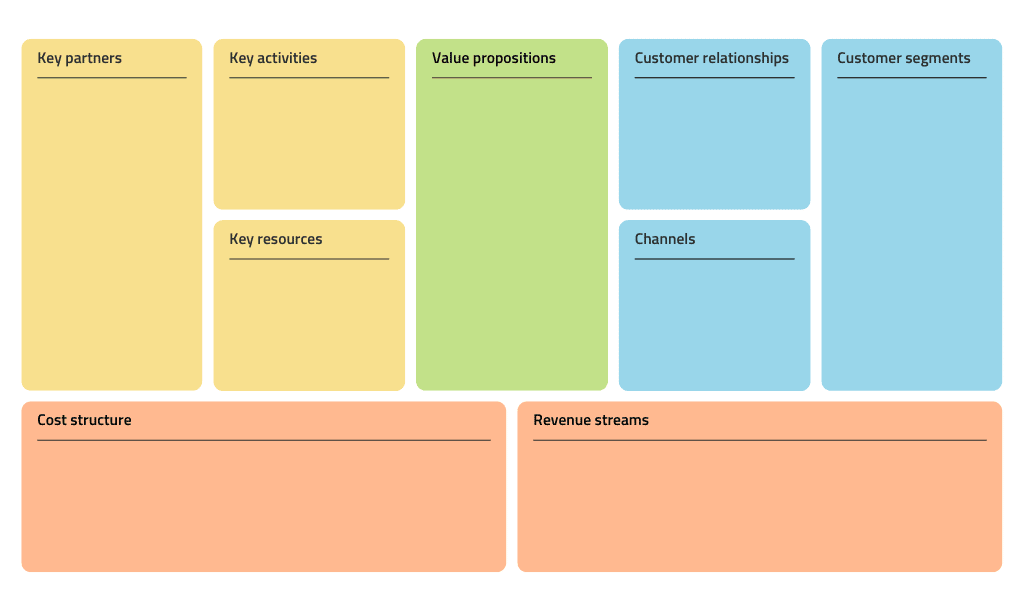Are you in your prime entrepreneurial phase but don’t know how to bring your business idea to life? Or are you wanting to improve your existing business model or plan and feel overwhelmed? The Business Model Canvas (BMC) could be your saving grace.

Source: Business Model Canvas created by Carbon Group
Value proposition
The value proposition refers to the fundamental concept of the exchange of value between your business and your customer/clients. Value is usually exchanged from a customer when a problem is solved or pain is relieved for them by your business.
When determining your value proposition, good questions to ask yourself include:
- What problem is my product or service solving?
- Why would someone want to have this problem solved?
- Would someone pay to have this problem solved?
- What is the underlying motivator for this problem?
The value proposition can only really be achieved when you understand your customers.
Customer segments
When you’re aware of who your customers are, it makes it a lot easier to understand how your product or service will provide them with a solution. It also helps determine who you shouldn’t be targeting.
General questions you can ask yourself when determining your customer segments are:
- Who are you selling your product or service to?
- Where do they live?
- What gender are they?
- How old are they?
- What are their interests?
- What common behaviours do they share? and,
- What is the market size and how many people are in your customer segments?
Once you identify who your customer segments are, you can go ahead and create customer personas for each segment. This will help when you start conducting market research and testing your product on your customers.
Customer relationships
Customer relationships refer to how you plan on interacting with your customers throughout their customer journey.
You could interact with your customers:
- Personally (in person, by email or phone)
- Assigning each customer a dedicated customer representative
- Self-service (this means you have no relationship with the customer but provide what the customer needs to help themselves)
- Through automated processes and machinery
- Online communities where customers can help each other to solve their own problems, or
- Co-creation (customer is involved in designing or developing the product).
Channels
Channels are about how your customers interact with your business and become part of the sales cycle. Understanding how to reach your customers is crucial to the success of your business, especially if you’re in the start-up phase.
There are typically two types of channels:
- Owned channels- company website, social media sites, in-house sales, email marketing.
- Partner channels – partner-owned websites, wholesale distribution, networking and tradeshow events, traditional advertising.
When finding what channels are best suited for your business or product, make sure you ask yourself:
- How do you plan to tell the customer segment about the value proposition?
- Where are your customers?
- Are they on social media? Are they at an event or conference?
- Do they listen to the radio or are they watching TV?
Revenue streams
Revenue streams are defined as the various sources from which a business earns money from the sale of goods or the provision of services. The types of revenue that a business records on its accounts depend on the types of activities carried out by the business.
Common revenue models are:
- Transaction-based revenue: proceeds from sales of goods.
- Service revenue: providing a service to customers and are calculated based on time.
- Project revenue: earned through one-time projects with existing or new customers.
- Recurring revenue: Earnings from ongoing payments for continuing services or after-sale services to customers.
- Subscription fees (e.g., monthly fees for streaming services or food delivery)
- Renting, leasing, or lending assets
- Licensing content to third parties
- Brokerage fees
- Advertising fees
Key activities
Key activities are the actions that your business undertakes to achieve the value proposition for your customers.
Three categories of key activities are:
- Production: designing, manufacturing and delivering a product in significant quantities and/or of superior quality.
- Problem-solving: finding new solutions to individual problems faced by customers.
- Platform/network: creating and maintaining platforms.
Key resources
Key resources refer to what physical resources are needed to achieve the key activities or actions. Essentially, what does your business need to successfully do business?
Some key resources could include:
- Buildings and office space
- Computers, inventory and equipment
- Employees
- Brands, patents, IP and copyright
- Cash and lines of credit
- Electricity, gas, water and internet
This section is extremely important for start-ups because during the early stages of your business, it’s very likely you’ll be using your own finance. You’ll want to make sure your budget is as accurate as possible so your personal finances aren’t affected.
Key partners
To deliver value to the customer, you might need to rely on external companies, suppliers or third parties. In the BMC, these people are called key partners.
Some examples of key partners are:
- For a baker to be able to deliver making a cake, they will need to buy groceries from the supermarket.
- If an event planning company is running an event on behalf of their client, they may need to rely on external AV suppliers to help with the sound and overall set up.
Cost structures
Cost structures refer to what is the monetary cost of operating your business.
Have you thought about:
- How much it will cost to achieve your key business activities?
- How much will you need to spend on key resources and key partnerships?
- How much does it cost to achieve the value proposition for your customers or clients?
- Are there any additional costs, and if so how much will that cost?
- What are the legal and compliance requirements?
- What is the overall cost of operating your business?
- How much will it cost to hire employees?
Ready to create your Business Model Canvas?
A Business Model Canvas is most beneficial for start-ups and businesses looking to grow. Your BMC is a living document meaning you don’t just fill it out once and never look at it again. It’s something you should be coming back to and reviewing regularly.
Want some help building your start-up, growing your business and creating products and services that your customers will love? Or perhaps, you want an outside opinion to review your existing Business Model Canvas with fresh eyes? Either way, our team of financial people are here to help you. Get in touch with our team today to learn how we can help you.





















